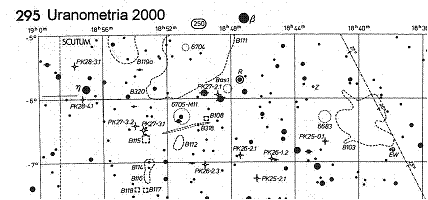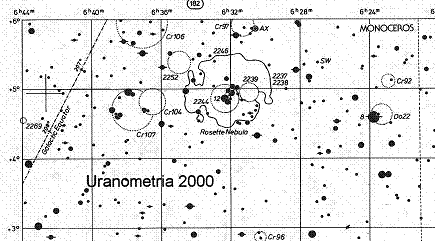Chasing Numbers
Jack Kramer
A few months ago, an Internet correspondent broached the subject of observing goals. His wife agreed he could get a larger telescope once he had logged 1000 deep sky ob-jects; his current tally stood at about 400 objects with an 8-inch reflector. The late observing guru Walter Scott Houston wrote in S&T that most amateurs would never exhaust the capabilities of a 6-inch scope, so 1000 objects seems attainable for his scope. Anyway, this got us on the subject of target objects.
It's a good habit to log your observations, and many of us set number goals as we proceed. It helps you stay focused. But I feel it's even more important to actually say something about the objects in your log book. How did the object look in your telescope and what features were you able to pick out? Drawings of the object are even better. If all you do is simply record an object as "seen", then you're a mere collector of deep sky objects and not an observer.
For those who are intent on adding more objects to their log, there are many sources from which to find targets. Just about all of us started out with the Messier list of 108 objects. (Two in the list of 110 objects are designated as "spurious".) Given decent enough skies, all of those should be visible in a 90mm telescope. But there's a whole bunch of bright deep sky objects that Messier never recorded. You might then work on the Herschel 400 or simply dive headlong into the New General Catalog (NGC). That alone gives you almost 8000 possible targets! Of course, some NGC objects are much too faint for most of our tele-scopes. The same is true of the Index Catalog (IC) sup-plement to the NGC.
Then there are loads of other catalogs, and despite their general unfamiliarity, many of them sport objects well within the grasp of amateur-sized scopes. I won't cover them all here, just the ones that offer the best chance to fill out your observing log. However, few of these objects are shown in popular charts like the Sky Atlas 2000. Instead, they tend to be charted only in more highly detailed atlases like the Uranometria.
Barnard (B) - Originated by Edward Emerson Barnard, this catalog lists 366 dark nebulae - dust clouds that are visible by the fact that they block the light of stars behind them. They appear as star-poor areas, with many Barnard objects in the dusty summer Milky Way. Sometimes they're easy to see, but because many are quite large, it's best to use your widest field eyepiece in a fast telescope. Currently, 28 Barnard objects grace my log. The famed Horsehead Nebula (B33) is a Barnard object that blocks out a patch of the background nebula IC434. Many of these dark nebulae also appear in the larger Lynd's Dark Nebulae (LDN) catalog, but most charts show them with the Barnard designation as in the Uranometria cut shown here.
 In the two chart examples here, sample objects are in the vicinity of familiar features - M11 and the Rosette Nebula - which gives you a good starting point when looking for them.
In the two chart examples here, sample objects are in the vicinity of familiar features - M11 and the Rosette Nebula - which gives you a good starting point when looking for them.
Collinder (Cr) - This is a catalog of open clusters that have been more recently identified as true clusters in which the stars are gravitationally bound. Many Cr clusters have stars that are bright enough to be easily seen. The problem is that they often are very loose and sparse - hard to identify as discrete objects. That in itself makes it some-thing of a game as you try to separate a cluster from the background stars. So far I've logged 30 Collinder clusters, many using just a 90mm wide field refractor. Larger scopes tend to show a greater number of background stars, sometimes making identification more difficult.
 Dolidze (Do) - This is very similar to the Collinder list. I've managed to capture 15 Do clusters, again usually with small wide-field scopes.
Dolidze (Do) - This is very similar to the Collinder list. I've managed to capture 15 Do clusters, again usually with small wide-field scopes.
Perek-Kohoutek (PK) - Lists 1,455 planetary nebulae. Unfortunately, most are quite faint and difficult to distin-guish from a background star. I've managed to see only 7 of these objects, almost all using an OIII filter.
Stock - Again, this is a listing of open clusters with char-acteristics very similar to Collinder objects. I've netted 9 Stock clusters, all in the fall and winter sky.
Most lists include objects from other catalogs. For exam-ple, all the Mellotte (Mel) and Trumpler (Tr) clusters I've recorded turned out to be either Messier, Collinder, or Harvard objects, as well. However, M24 and M45 have no alternate designation other than Mel 197 and Mel 22, re-spectively. If you consistently base your log on the same star atlas, it's rare that you'll double record an object under two different designations. The free-of-charge Saguaro database is also invaluable as a cross reference, with de-tailed info on over 10,000 deep sky objects. It can be downloaded at:
http://www.saguaroastro.org/content/downloads.htm
Since the bulk of deep sky objects appear in multiple cata-logs, they may be shown with two or more designations. Recommended observing lists can be helpful by showing the best objects regardless of the source. The one list I don't use is British astronomy popularizer Patrick Moore's Caldwell catalog. It lists previously identified objects, not-ing particularly unique aspects; unfortunately, it overlays each of them with a superfluous and confusing "Caldwell" designation. Thankfully it's been ignored by many writers of observing guides. I find a good atlas plus the Saguaro database to be the best means of planning a night's ob-serving ... and adding objects to the log.
Published in the August 2009 issue of the NightTimes




